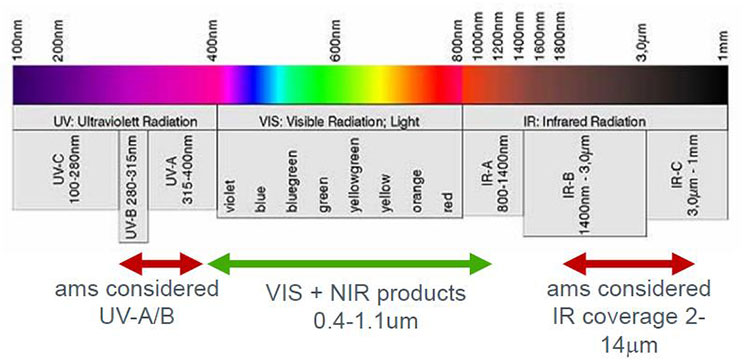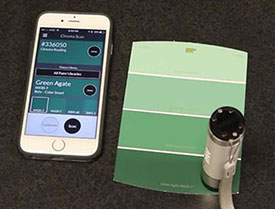Spectral Sensors

Have you ever asked yourself what color something is when trying to match paint, cosmetics or clothes?
So you are at the hardware store and need to pick up some paint for a room. You don’t plan on painting the entire area, but you either want to do some touch ups or finish what you had started. The problem is you don’t know the exact color that you need, or in some cases the paint colors faded or darkened over time. So what do you do? You pick up what you think is the closest only to go back home and find out that you are off. Oh, that is so frustrating and we have all been there.
Wouldn’t it be nice if we had the ability to determine for certain what the color really is so that you can get a perfect match? Well, Spectral Sensors from ams can do just that and whole lot more.
Here is another example. You are at the grocery store picking up fruit and vegetables. If you are like me (just picking up fruit), you want to pick the apple that is the sweetest. So you buy some apples based on the shiny, glossy look only to find out they are not that sweet. Now if you had a device that could scan the color of that apple and tell you how sweet it is before you buy it, that would be amazing. I know this all sounds so science fictional, kind of like Dr. McCoy from Star Trek and his Tricorder.

Well let me tell you this science fiction stuff is happening today. But before we get into the sensors, we need to understand what exactly color is. So I went to the color expert from my youth—Crayola—to get a better understanding, and this is what I found: “Color is the aspect of things caused by differing qualities of light being reflected or emitted by them.” Color is light being reflected or being emitted. And from my science 101 class I remember that light is a wavelength of the electromagnetic spectrum.
To get a better understanding on wavelengths from a more scientific source, I went to the National Aeronautics and Space Administration website: The human eye can see a very small band of light waves from about 400 to 700 nanometers. This is known as Visible Radiation (VIS) and is represented by the common colors of Violet, Indigo, Blue, Green, Yellow, Orange and Red. Or as I learned it so many years ago: ROYGBIV.
Wavelengths smaller than VIS include Ultraviolet (UV), X-Ray and Gamma Rays. With wavelengths greater than VIS, you get into Infrared Radiation (IR), then Microwave and finally Radio waves. IR can be broken down in to Near Infrared Radiation (NIR), Mid-Infrared (MIR) and Far-Infrared (FIR). See below.

We understand VIS and why that is important but why do we even care about UV and IR ranges, let alone subdivision of IR? Because UV, VIS, NIR and MIR sensors can be used in such applications as oil quantity (VIS), Milk adulteration (IR), Agriculture (VIS & NIR), Health (Ultraviolet UV, VIS, MIR) and Environment (NIR). How is that possible, and who or what is ams?
 Node Chroma
Node Chroma
ams is an Austrian-based sensor company which has a series of spectral sensors that use XYZ tri-stimulus technology that can measure light waves in the VIS and IR (both NIR and MIR) ranges. They have a series of sensing engines which include the AS7261 (XYZ +IR), the AS7262 (6-channel VIS) and the AS7263 (6-channel VIS +NIR).
All this science stuff seems so far off in the future, but what about a real application now? Variable, Inc did just that by using the AS7261 in creating a handheld wireless color scanner called the “Node Chroma”. This real scanner can detect an object’s color and transmit the data via Bluetooth to an app on your phone. The exact color is indicated on the app, and by using the power of the Cloud you can access color palettes for the exact color mixture. There is a great video on the AS7261 here. The image on the left is the Node Chroma in use.
Think of all the applications that you can use something like this for. No more mismatched paints for finishing off that last wall.
Now what is an example of this technology used in the IR spectral range? Using a NIR Spectral Sensor, one can tell the sweetness of an apple by its color. WHAT? I’ll say that again. Using a NIR Spectral Sensor, one can tell the sweetness of an apple by its color. This sounds too good to be true, so how does that work? Sweetness is related to a particulate wavelength and its reflective absorbance. I found this great slide from ams that explains very well.

Another great example of an existing product is the “Primelab 1.0 Multitest” which is a handheld photometer using one of ams’ sensors. This device can determine water quality by measuring more than 100 parameters. Once you know the water quality, you can take steps to maintain, adjust or improve the quality as needed. Other liquid applications include determining fat content in milk and cheese. Using the NIR range of 350-900 nm, one can assess the fat content and make the required adjustments for an optimal product.
Our world is so full of wonderful colors, and finding that right color can be a challenge especially if you are trying to match to an existing color. There are numerous applications that go beyond the visual spectrum of the human eye into the Infrared spectrum. Spectral Sensors from ams are a great idea for industrial, commercial and health projects. Never pick the wrong color or a sour apple again. Dr. McCoy would be proud.

Have questions or comments? Continue the conversation on TechForum, Digi-Key's online community and technical resource.
Visit TechForum





 Stephen Wegscheid 是 DigiKey 的資深半導體產品經理,專門負責類比/線性電子產品、連線產品和單板電腦。他擁有明尼蘇達州伯米吉州立大學的理科碩士學位,在設計、製造和經銷領域擁有超過 25 年的經歷。此外,他個人也擁有美國專利。
Stephen Wegscheid 是 DigiKey 的資深半導體產品經理,專門負責類比/線性電子產品、連線產品和單板電腦。他擁有明尼蘇達州伯米吉州立大學的理科碩士學位,在設計、製造和經銷領域擁有超過 25 年的經歷。此外,他個人也擁有美國專利。




